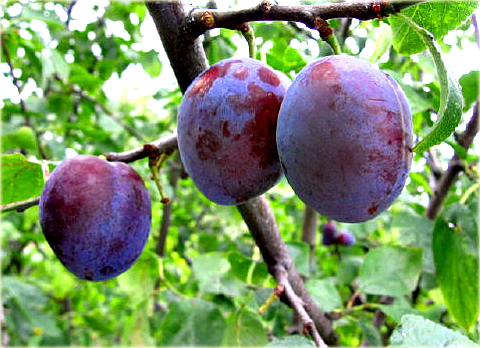 PLUM
PLUM
Noble varieties of plums usually take the form of trees that grow up to a height 6-10 m, with a spherical crown, oval, conical or irregular. The plum blossom is mounted on a stalk of various lengths, and flower buds can be found on both shoots, as well as on long shoots, and usually include from 1 into 3 flowers. The plum leaves are generally round in shape, elliptical, oval or ovoid. The edge of the leaf is notched or serrated, sometimes with cilia. The leaves are of different sizes, depending on the varieties and the place, in which they grow up on a tree. The trees of most varieties of plums live on average 30-35 lat, and their maximum productivity occurs in the period from 15 into 25 year. Plum trees require a warmer climate, because they are not very resistant to low temperatures and therefore, that it determines the good quality of the fruit. In addition, plums require (the most of all fruit trees) moisture. The soil requirements of plums are generally low, but these trees need soil that is sufficiently moist, especially Hungarian. They also grow well and bear fruit in peaty soils.
Plums are grafted on Alych or Wangenheim's Hungarian and they grow quite luxuriantly, taking up more space than apple trees or dwarf pear trees. Plum trees grafted in Wangenheim's Hungarian plant grow less and are semi-dwarf trees.
Alych (often wrongly called mirabelle) it can also be grown for fruit or for a hedge, giving early-ripening fruit (in late July and early August). Ałycz cultivars (replacing the proper mirabelles not grown here) they are yellow or red in color. The fruit is suitable for direct consumption and preserves, especially for compotes.
The earliest plum ripening is Ruth Gerstetter. It is a German variety. The tree grows moderately fast. Creates an irregular crown, sufficiently loose. The branches of the second order point straight up and have numerous branches covered with densely spotted shoots. It enters the fruiting period early, but it does not bear fruit very regularly. Unfortunately, it is not resistant to frost. Requires warm and fertile soil. It produces medium-sized fruit, with a weight of about 35 g, oval, slightly flattened at both ends. The height of the fruit – 4,2 Cm, and the thickness 3,6 Cm. The ventral side has a deep furrow, which divides the fruit into two unequal parts. The peel of the fruit is navy blue with a purple tinge, covered with blue bloom, easily peeling off the flesh. Green-yellow flesh, quite compact, guilty, sweet at full maturity, not very aromatic, well off the stone. Depending on the climatic conditions, the fruits ripen in the first or second half of July. Ripe fruits fall off.
The later maturing variety is Fryga. It is a new variety that is still not very widespread. The tree grows moderately fast. Creates a wide conical crown, not very compacted. It is sufficiently resistant to frost, resistant to diseases. In the collection of the Research Institute of Pomology and Floriculture, it was distinguished by fertility and therefore it was included in the selection. It produces medium-sized or large fruit, slightly tapering towards the top, while on the side of the peduncle, it is flatter. Thin skin, quite strong, light yellow or orange, with a carmine blush, with spots, covered with a blue-white bloom. Greenish-yellow flesh, juicy, sweet, with a spicy aroma, well off the stone. In warm summers and in good positions, the fruit ripens at the end of July.
The Peach variety ripens almost simultaneously with Fryga. The tree grows vigorously, creating a spreading crown, with numerous shoots. It enters the fruiting period on average, but it bears fruit irregularly, alternately. Sensitive to frost. Quite disease resistant. Requires warm and sheltered positions, fertile and moist soils. On dry and poor soils, it develops fruit poorly, and with a worse taste. They also descend prematurely. It produces large fruit with a weight 50-55 g, almost spherical. Pink-yellow skin, covered with irregular, with a dark red blush and light purple bloom and numerous spots, firm, fused with the flesh. Yellow flesh, quite compact, juicy, with a spicy flavor, deviating badly from the stone.
Later a new Swedish variety ripens – Opal. The tree grows moderately fast. It starts bearing fruit very early and bears fruit abundantly. It produces medium-sized fruit, about weight 25-30 g. Yellow skin with a purple-red blush. Yellowish-green flesh, juicy, aromatic. The stone is well off the flesh. The fruits ripen in the first ten days of August. They fall off when ripe.